Armenia has its own special and unique appearance. You can feel peace of mind that allows you to feel as you are in another dimension. You can start to appreciate the true meaning of life and start to feel harmonious which come from the nature and
come from the life itself. Armenia is a very ancient country. And it has very interesting history. It begins from its name. The original Armenian name was Hayk. Hayk was the legendary patriarch and founder of the Armenian nation. Later Hayastan translated as the land of Hail and consisting of the name Haik and the suffix '-stan'(land).
Armenia is the first christian country and it was adopted by Saint Gregory the Illuminator. He is the patron saint and first official head of the Armenian Apostolic Church. He was a religious leader who is credited with converting Armenia from paganism to Christianity, Armenia thus being the first country to adopt Christianity as its official religion in 301 A.D. Gregory baptized king Trdat (now known as Trdat the Great) along with members of the royal court and upper class as Christians. Trdat issued a decree by which he granted Gregory full rights to begin carrying out the conversion of the entire nation to the Chrsitian faith. The same year Armenia became the first country to adopt Christianity as its state religion.
Zvartnots International Airport
Zvartnots International Airport is located near Zvartnots Cathedral, 10 km west of Yerevan. The airport was built in 1961. It is now the busiest airport in Armenia and the Caucasus. The draftsmen of the airport included architects M. Khachikyan, A.
Tarkhamyan, J. Sheqhlyan, L. Cherkezyan and designers H. Tigranyan, A. Meschyan and constructor M. Baghdasaryan. The airport was renovated in the 1980s, with the development of a new terminal area, in order to meet domestic traffic demands within the Soviet Union.
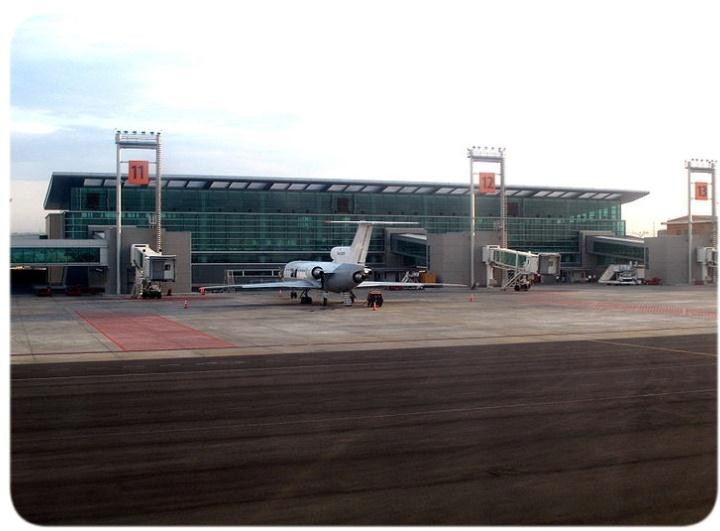
When Armenia declared its independence from the Soviet Union in the 1990s, the considerable growth of cargo shipments resulted in the construction of a new cargo terminal in 1998, with modern technical equipment that can handle about 100,000 tons of cargo annually.
In 2004, the construction of a new international terminal began, at a cost of $100 million. It covers an area of 19,200 m2 and can handle 2 million passengers a year. The building of this terminal is part of the 30-year concession agreement signed by the Armenian Government and Armenia International Airports.
On September 14, 2006 the newly built arrivals hall was opened. The new international terminal with its departures section was opened on June 1, 2007.
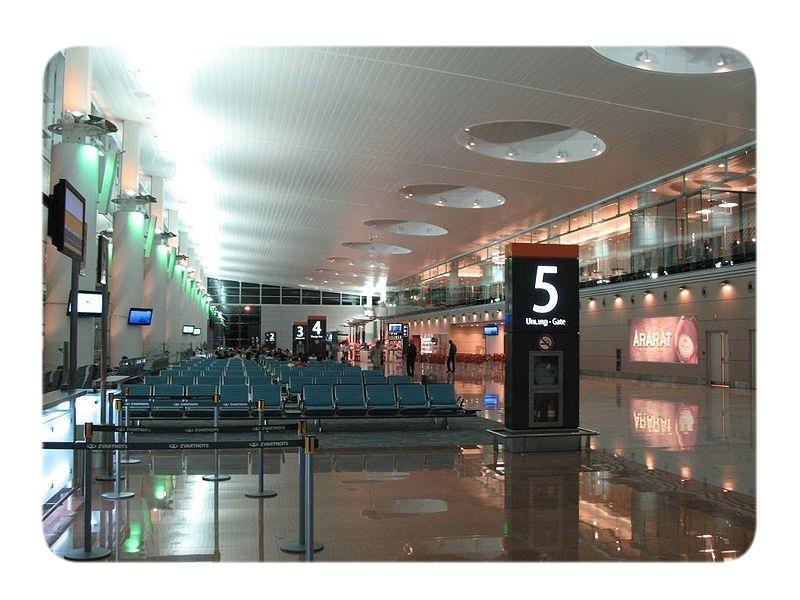 A new terminal
A new terminal
Many international airlines now operate from Zvartnots, connecting Yerevan to the world’s most important cities, including Amsterdam, Athens, Barcelona, Berlin, Dubai, London, Moscow, Paris, Rome, Tehran, Vienna, Warsaw and Zurich. Altogether around 60 routes will be scheduled to fly from Zvartnots.
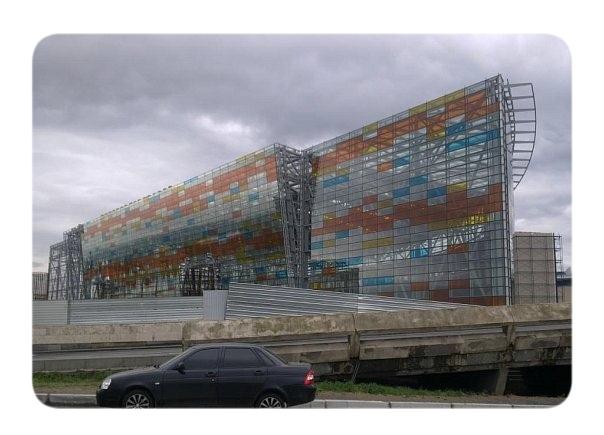 The second new terminal under the construction
The second new terminal under the construction
In the spring of 2008, the construction of a new passenger terminal began, in order to supplement the existing concourse. The completion of the project is expected in 2011. The new passenger terminal, occupying 52,000 m2, will double the number of passenger check- in counters and security control points. A new underground parking lot will be built, with a parking area for more than 800 cars. When this terminal is accomplished, Zvartnots International Airport will become a leader among airports in the South Caucasus. It will be able to serve 3,2 million passengers annually. The entire project will cost $173 million, part of which is on loan from the Asian Development Bank.
Erebuni-Yerevan
In the valley of Biblical Mount Ararat lies the beautiful ancient city of Yerevan, the 12th capital of Armenia. Yerevan was built around the city-fortress of Erebuni established by the King Argishti the First king of Urartu in 782 BC. The ruins of Erebuni still stand in
the south stern part of the city. In Yerevan there is a museum which name is Erebuni.
 Erebuni museum
Erebuni museum
It is established in 1968. The opening of the museum was timed to coincide with the 2750th anniversary of Yerevan. The Museum stands at the foot of the Arin Berd hill, on the top of which the Urartian Fortress Erebouni has stood since 782 BC. The City-Fortress was excavated, some parts of the structure were reinforced and restored, and the fortress was turned into an outdoor Museum.
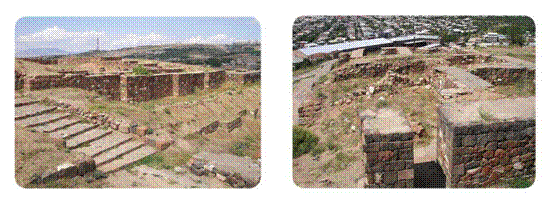 The outdoor of Museum (The Urartian Fortress Erebuni)
The outdoor of Museum (The Urartian Fortress Erebuni)
In museum there is huge collection of artifacts, sups, jars, bronze bracelets, glass, agate beads and many other things that tell us about the life of the citadel, the tastes and habits of its inhabitants.
Armenian alphabet and Matenadaran
Two of the most notable events under Arsacid rule in Armenian history were the conversion of Armenia to Christianity and the creation of the Armenian alphabet by Mesrop Mashtots in 405 A.D.
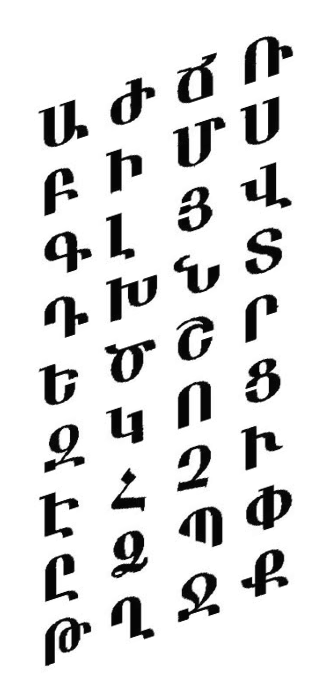 Armenian Alphabet (36 letters)
Armenian Alphabet (36 letters)
The alphabet was contained 36 letters but later were added two more letters. Armenian alphabet has been used to write the two modern dialects of Eastern Armenian and Western Armenian. There are 17,000 manuscripts of Mesrop Mashtots which commonly referred to as the Matenadaran and it is an ancient manuscript repository located in Yerevan.
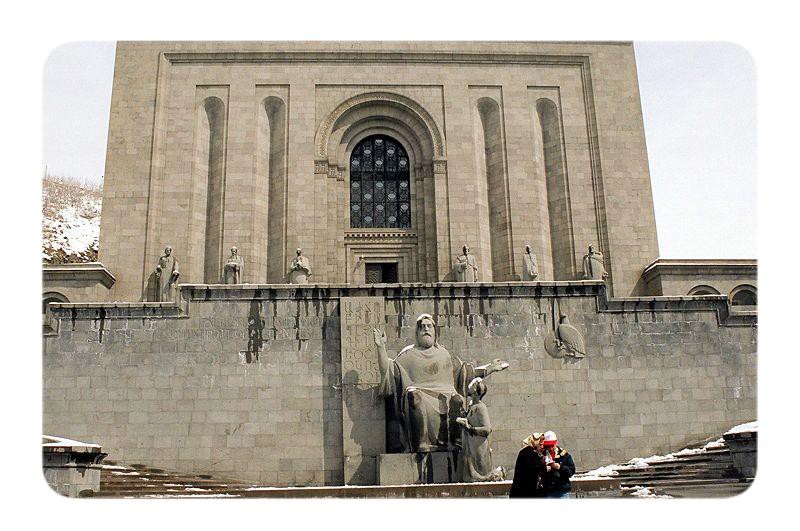 Mesrop Mashtots and Matenadaran
Mesrop Mashtots and Matenadaran
Matenadaran holds one of the world's richest depositories of medieval manuscripts and books which span a broad range subjects, including history, philosophy, medicine, literature, art history and cosmography in Armenian and many other languages.
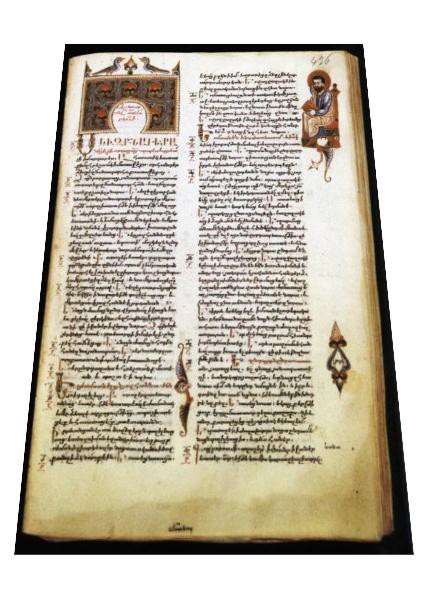 The ancient manuscript
The ancient manuscript
The Armenian collection at the Matenadaran is very rich in manuscripts dealing in all fields of humanities, but particularly historiography and philosophy. The writings of classical and medieval historians Movses Khorenatsi, Yeghishe and Aristakes Lastivertsi are preserved here, as are the legal, philosophical and theological writings of other notable Armenian figures. There are also writings of Grigor Narekatsi and Nerses Shnorhali.
Hovhannes Tumanyan and his museum in Yerevan
Hovhannes Tumanyan is considered to be one of the greatest Armenian poets and writers. His work was mostly written on tragic form, often centering on the harsh lives in villagers in the Lori region where he was born.
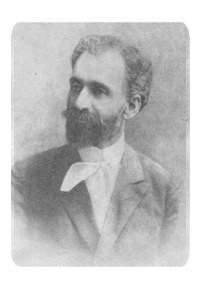 Hovhannes Tumanyan
Hovhannes Tumanyan
Tumanyan is usually regarded in Armenian circles as “All-Armenian poet”. He earned this title when the Catholicos of Armenia had ordered that Armenian refugees from the west not enter certain areas of his church and house, since he is considered to be “The Catholicos of All Armenians”. Tumanyan in response declined that decision claiming that the refugees could seek relief in the Catholicos’ quarters under order of “The Poet of All Armenians” He created lyrics, fables, epic poems and translations into Armenian of Byron, Goethe and Pushkin.
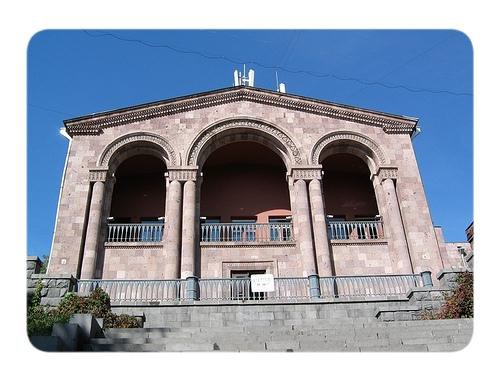 H. Tumanyan House-Museum
H. Tumanyan House-Museum
Hovhannes Tumanyan Museum functions since 1953. The founder and the first director was the poet’s daughter. Copies of manuscripts, photo documents and original illustrations of Tumanyan writing, works of such artists as G. Yeritsyan, A.Grigoryan, G.Khanjyan are exhibited here.
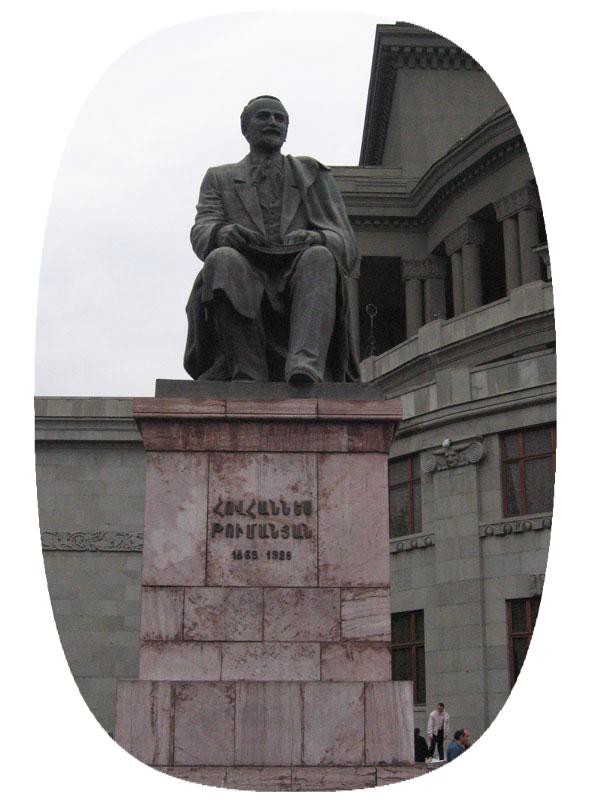 The statue of Tumanyan in Opera Square
The statue of Tumanyan in Opera Square
In 1969, on the occasion of the 100th anniversary of the great writer, a new two-storey building was built to house materials related to Tumanyan’s life and work including his personal items, documents, manuscripts, sketches, and publications in more than 40 languages.
The second floor replicates in minute detail Tumanyan’s Tbilisi apartment where the writer lived the last 14 years of his life. The museum also accommodates his private library of about 8000 volumes dedicated to studies on the Caucasus and Armenia, religion, culture, history and folklore of various nations. The museum is a large research center and organizes literary events and performances dedicated to the brilliant writer Tumanyan.
Sergei Paranjanov House-Museum
Many people haven’t heard of Paranjanov when they first visit Yerevan, but those you see it, were so impressed. The whimsical art of this very multi-faced man captures everyone’s imagination, and the longer you stay, the more you notice
and enjoy. The Museum was founded in 1988 when Paranjanov moved to Yerevan from Tbilisi. Paranjanov himself choose the place and construction project of museum. The Museum was opened in 1991 a year after Paranjanov's death. It contains more than 200 works of the artist as well as furnishing of his home in Tbilisi. The collection and archives of the exhibition are continuously expanded.
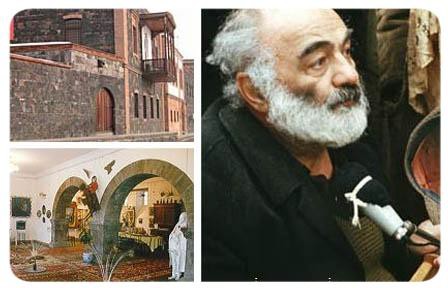
Over the years the Museum has organized 26 exhibitions, including those at Cannes, Thessaloniki, Tokyo, Moscow, Rome, Tehran and Beijing. The Museum's director Zaven Sarkissyan is an acclaimed photographer and was Paranjanov's friend. "The Color of Pomegranates" was the one of the best contemporary film, strikes with its perfection of beauty. The museum is one of the cultural centers of Yerevan.
St Gregory the Illuminator Cathedral
his cathedral was completed in 2001 to commemorate the 1700th anniversary of Armenia as a Christian nation. The holy relics of St Gregory the Armenian were given back to the Armenian Church by the Vatican in 2001 and placed in the
cathedral. The building is a megalomaniac exaggeration of traditional Armenian Church Architecture.
As opposed to all other churches in Yerevan the Cathedral is full of light and does not carry any stand for candles. The candle-house is a separate structure next door. However, the complex is vastly and visibly unfinished.
The Armenian Genocide Memorial and Museum
Tsitsernakaberd is a memorial dedicated to the victims of the Armenian Genocide; it is located on a hill overlooking Yerevan. Every year on April 24, hundreds of thousands of Armenians gather here to remember the victims of the 1915 Armenian Genocide that took place in the Ottoman Empire carried out by the Turkish government. The memorial sits on one of three hills along the Hrazdan River that carry the name
Tsitsernakaberd, and was the site of what was once an Iron Age fortress.
Construction of the memorial began in 1966 in response to the 1965 Yerevan demonstrations during which one million people demonstrated in Yerevan for 24 hours to commemorate the 50th anniversary of the Genocide. It was completed in 1968.
The 44 meter stele symbolizes the national rebirth of Armenians.
12 slabs are positioned in a circle, representing the 12 lost provinces in present day Turkey. In the center of the circle, at a depth of 1.5 meters, there use an eternal flame.

The Armenian Genocide Museum opened its doors in 1995, concurrently commemorating the 80th anniversary of the Genocide. The Museum structure, planned by architects S. Kalashian, A. Tarkhanyan and sculptor F, Araqelyan. This Museum has a unique design. Since opening its doors, the Museum has received many thousands of visitors including schoolchildren, college students and huge numbers of tourists from all over the world.
The impressive two-story building is built directly into the side of a fill so as not to detract from the imposing presence of the Genocide Monument nearby. The roof of the Museum is flat and covered with concrete tiles. It overlooks the scenic Ararat Valley and majestic Mount Ararat. The first floor of the Museum is subterranean and houses the administrative, engineering and technical maintenance offices as well as Komitas Hall, which seats 170 people. Here also are situated the storage rooms for medium artifacts and scientific objects, as well as library and a reading hall.
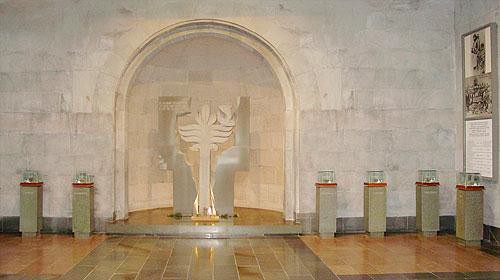
The Museum exhibit is located on the second floor in a space just over 1.000 square meters in size. There are three main indoor exhibit halls and an outer gallery with its own hall. The Genocide Monument is designed to memorialize the innocent victims of the first Genocide of the 20th century. The exhibit has many large photographs taken during 1915-1917, archival documents, portraits of prominent Armenians, victims of the atrocities, friends of the Armenian people, and documentary films.
The tables displayed in the third hall compare the Armenian population figures in 1914 and 1922 and also define the number of people deported and killed.
Mother Armenia
Mother Armenia (Mayr Hayastan) is the female personification of Armenia. Her most visual rendering is a monumental statue in Victory Park overlooking the capital city of Yerevan, Armenia.
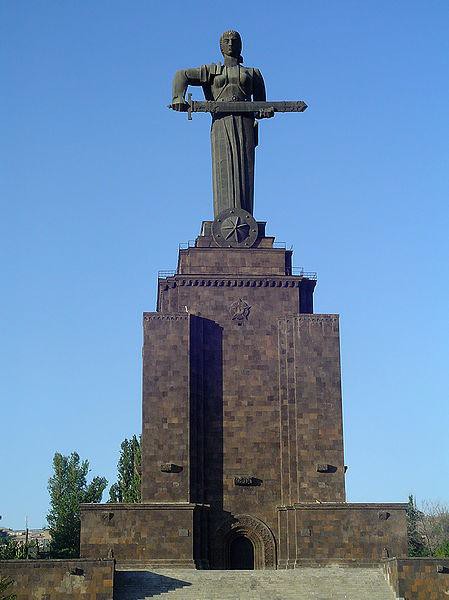 The Mother Armenia
The Mother Armenia
The Mother Armenia statue symbolizes peace through strength. It can remind viewers of some of the prominent female figures in Armenian history, such as Sose Mayrig and others, who took up arms to help their husbands in their clashes with Turkish troops and Kurdish irregulars. It is also recalls the important status and value attributed to the older female members of an Armenian family.
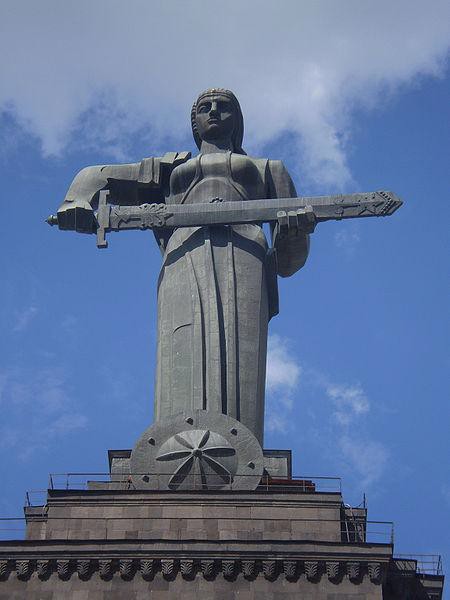
Its strategic location of being on a hill overlooking Yerevan makes it look like she is the guardian of the Armenian capital. Each May 9, thousands walk past the statue of Mother Armenia to commemorate Armenia’s was dead. Inside the 50 meter tall pedestal is the Mother Armenia Museum of the Ministry of Defense. When first built, it was a military museum containing exhibits about World War II. Now a large proportion of the exhibition space is devoted to the Nagorno-Karabakh War of the 1980-1990’s. There are personal belongings, weapons and documents of the heroes and walls are decorated with their portraits. There is historical map on which Armenian forces worked for the capture of Shushi, among other historical artifacts
Armenian National Academy of Sciences
 NAS RA
NAS RA
The Armenian Academy of Sciences is the primary body that conducts research in and coordinates activities in the fields of science and social science in the Republic of Armenia.
Armenian Academy of Sciences (since 1993 - the National Academy of Sciences of the Republic of Armenia) was founded on 25 November 1943 on the basis of the USSR Academy of Sciences' Armenian Branch, organized in 1935.
One of the founders and the first President of NAS RA was Full Member of the USSR and Armenian Academy of Sciences Prof. Hovsep Orbeli. During 1947-1993 the President of NAS RA was Prof. Victor Ambartsumian, Full Member of the USSR and Armenian Academies of Sciences. During 1993-2006 the President of NAS was academician Fadey Sargsian. Since 2006 the President of NAS RA is academician Radik Martirosyan.
NAS RA is a highest state scientific self-governing organization which unites NAS Members and scientific staff of affiliated scientific and research institutions. The Academy promotes and carries out fundamental and applied research in different scientific fields, as well as coordinates research carried out throughout Armenia. NAS RA is an official scientific consultant to the highest Governing Bodies of Armenia.
As a state scientific organization NAS RA unifies the scientific and research institutes, subsidiary services and governing body - the Presidium of the Academy includes more than 50 scientific institutions and other organizations.
Several Institutes have experimental plants, special design bureaus, botanical gardens, etc. The Presidium of NAS RA also includes Fundamental Scientific Library, Scientific Information Center, International Scientific Educational Center,"Gitutyun" Publishing- House and subsidiary services.
The Academy of Sciences central location is in the capital of Armenia, Yerevan, although other branches exit in Gyumri, Sevan, Goris, Vanadzor and Ghapan.
A branch based in Aragatsotn studies astronomy at the Byurakan Observatory.
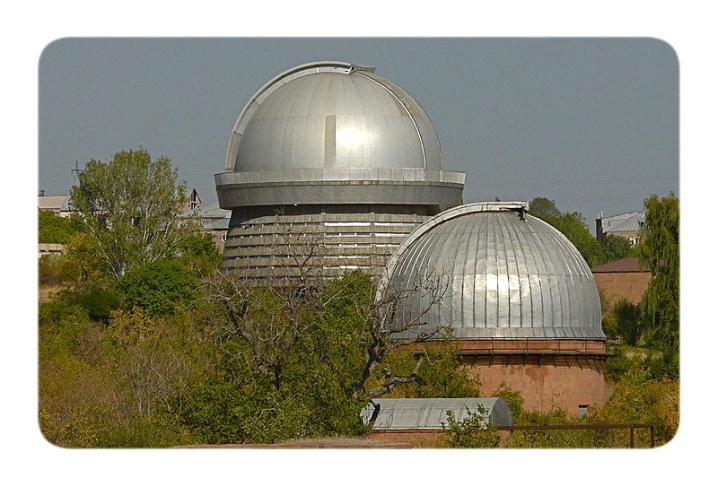 BAO
BAO
The Byurakan Astrophysical Observatory is an astronomical observatory owned and operated by the Armenian Academy of Sciences. It is located on the slope of Mount Aragats in the village of Byurakan in Armenia. Founded in 1946 by Viktor Ambartsumian, it was one of the main astronomy centers of the USSR. The observatory has discovered special star clusters-stellar associations more than 1,000 flare stars, dozens of Supernovae, hundreds of Herbig0Haro objects and cometary nebulae, hundreds of galaxies. Byurakan Observatory’s main telescope is a 2.6 m cassegrain reflector, along with a 1.5 m Scmidt camera as well as other smaller telescopes.
Republic Square
Republic Square is the big central town square in Yerevan. It is intersected by Amiryan Street, Abovian Street, Nalbandyan Street and Tigran Mets Street.
The square has a stone pattern in the center, meant to look like a traditional Armenian rug from above. The square has a large fountain in front of the National Art Gallery and History Museum, it has the Marriot Hotel, the Foreign Ministry, a post office and other establishments around it.
This is the center of Yerevan, where ceremonies and meetings are held and through which processions pass on holidays and holidays. The statue of Lenin used to be located in here, but when Armenia regained its independence, it was brought down.
 The Republic Square at night
The Republic Square at night The clock of the Government
The clock of the Government
The clock of the Government building on the Republic square was made in Moscow. In July 1941 was transferred to Yerevan. The diameter of the clock is 4 meter, the length of the big arrow is 188 cm, the length of the small arrow is 170 cm. The precision of the clock is big, in 24 hours only 2-3 seconds.
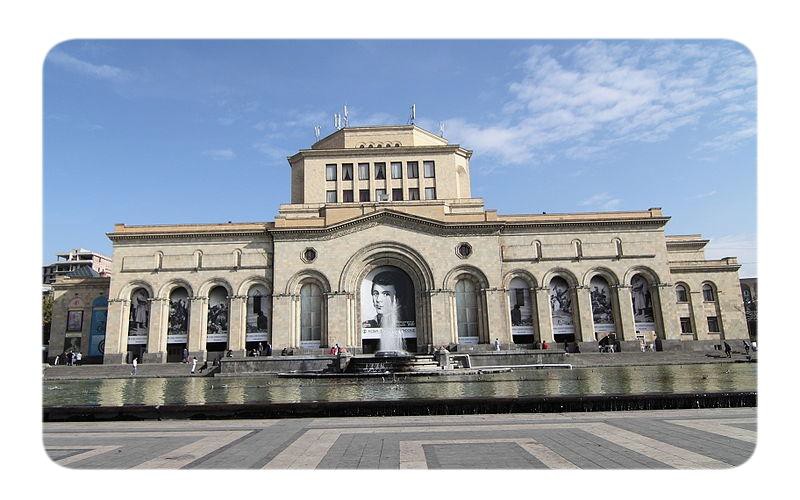 The National Art Gallery and The History Museum of Armenia
The National Art Gallery and The History Museum of Armenia
The National Gallery of Armenia is the national art gallery of Armenia founded in 1921 as the artistic section of the State Museum. It is located on the Republic Square in Yerevan.
The old Armenian subdivision owns works of famous Armenian artists beginning from the early medieval period.
Today its collection has over 26.000 artworks shown in Russian, Armenian and West European sections, including painting, sculptures, graphic and applied arts. Some of the works date back to the Middle Ages, which indicate Armenia’s rich tales and stories of the times. It houses paintings by many European masters as well.
The National Art Gallery of Armenia has many branches in Yerevan and other towns of the republic. The memorial-houses of the artist Hakob Kojoyan and the sculptor Ara Sarkissian are in the capital. They exhibit the best works of these two famous artists.
The History Museum of Armenia is the national museum of Armenia founded in 1919 as Ethnographic-Anthropological Museum-Library. It is also located on the Republic Square.
The History Museum of Armenia was formed on the basis of the collections of the Armenian Ethnographical Association of the Caucasus, No Nakhijevan Museum of Armenian Antiquities, Museum of Antiquities of Ani, Vagharshapat Repository of Ancient Manuscripts.
The museum represents an integral picture of the history and culture of Armenia from prehistoric times (one million years ago) till our days. The Museum presents the 4th-5th century Christian culture of Armenia with the unique architectural, sculptural and ceramic finds, excavated from the cities of Dvin and Ani, from the fortress of Amberd.
Now days Republic Square has dancing fountains, which you can see from 9 pm to midnight.
 Dancing fountains
Dancing fountains
Armenian Opera Theater
The Armenian National Academic Opera and Ballet Theatre in Yerevan was founded in 1932 and was opened on January 20, 1933. The theatre building was constructed in 1940 by the architect Alexander Tamanyan. In 1938, the theatre was named after
Alexander Spendiaryan, great Armenian composer, author of opera Almost which was performed in 1933 as a first performance at the theatre.
 The architect Alexandr Tamanyan
The architect Alexandr Tamanyan
Soon after the theatre foundation, a ballet troupe was established. Swan Lake by Pyotr Iliyich Tchaikovsky was the first performance in 1935. The opening of the theatre promoted the creation of new national operas and ballets. The first Armenian ballet was Happiness by Aram Khachaturian.
 Aram Khachatryan
Aram Khachatryan
On the basis of this ballet the composer soon created Gayane which has been performed all over the world. Since 1935 a unique Armenian opera, Anoush by Armen Tigranyan, has been performed. It was a great step in Armenian opera history. Anoush is in the repertoire of the theatre until now. Since it was opened, the Armenian National Opera and Ballet Theatre has performed more than 200 different operas and ballets by Armenian, Russian and West European composers.
Cascade
The Cascades, the name of a river cascade, were built in the 1970s, or rather began construction, since they were never finished. A huge monument nonetheless, these massive white stairs climb much of the way up the hillside, linking central Yerevan
to the WWI monument and platform on top, and behind it, the neighborhood called Monument. The stairs you climb are surrounded by beds of plants and flowers, and there are fountains and landings all the way up.
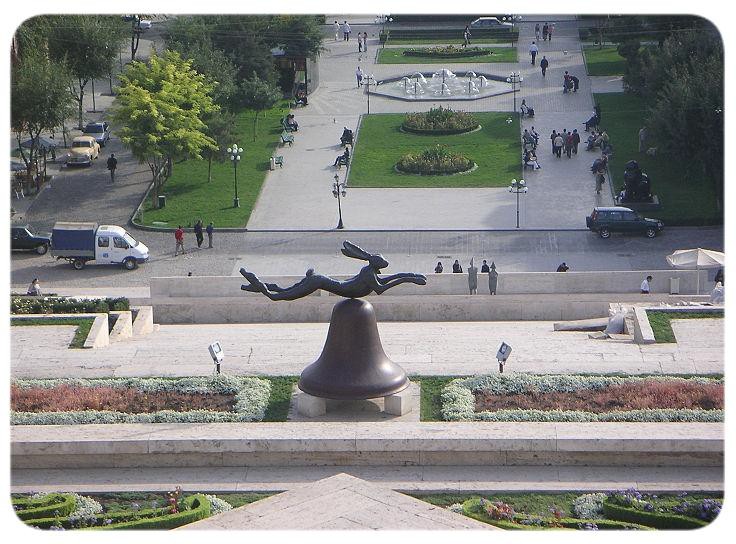
The Cascade is emerging as one of the focal points in Yerevan, similar to the Republic Square. It offers spectacular views of Mount Ararat and the city center. It is also popular for foreigners to jog on. Many tourists often don’t know that there are escalators in Cascade, so they climb the stairs all the way to the top. And it is very difficult especially in summer days, but it has its positive sight. From every stair you can see Yerevan and you can find something new until you get to the top.
The structure was privatized by Gerard Cafesjian and the top is the site of construction for the Cajesjian Museum of Contemporary Art. Some statues by various artists have already been brought in and placed all along monument, including Lynn Chadwick, Barry Flanagan, Sranislav Libensky and Jaroslava Brychtova.
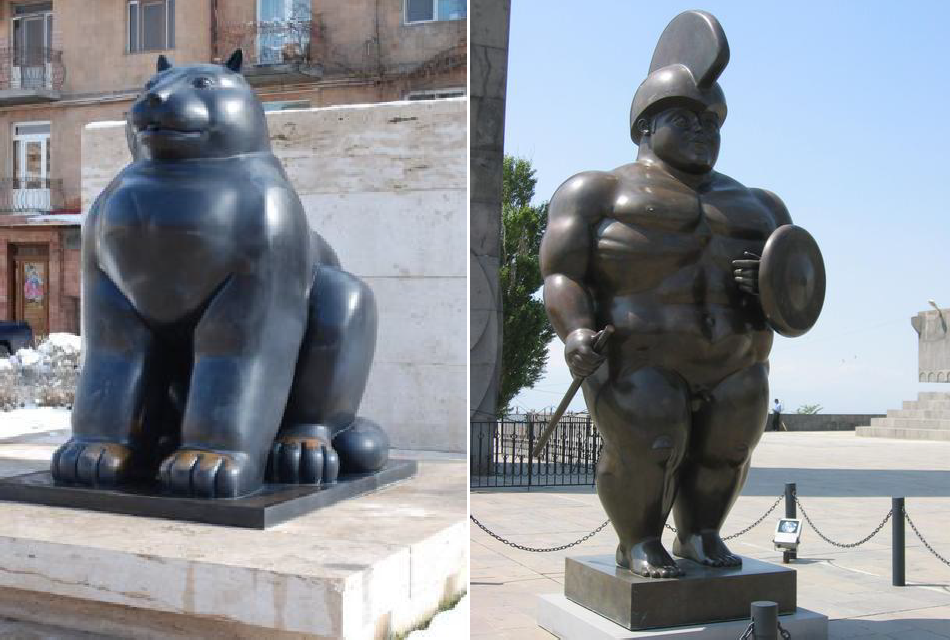 A black cut, A Roman Warrior
A black cut, A Roman Warrior
There are two statues by Fernando Botero a black cat at the bottom and a Roman Warrior at the top platform.
Yerevan’s Monuments
Yerevan is made up of multitude monuments. The statue of Sasuntsi Davit(David of Sasun) on horseback is located at the Sasuntsi Davit Metro station on Tigran Mets Street in Yerevan.
In the centre of the square, surrounded by the Railway Workers’ Cultural Centre, a cinema and residential blocks, stands the statue of Davit Sasuntsi, mythological hero of the Armenian folk epic poem. The sculptor was Yervand Kochar.
 The Railway Workers’ Cultural Centre
The Railway Workers’ Cultural Centre
The image of Davit, fearlessly defended his people from foreign invaders, is similar to that of the warriors in Russian folk legends. From generation to generation, from century to century, people have handed down tales f Davit’s deeds, his gigantic strength. The episode of the crucial battle when Davit, unwilling to shed the blood of the enemy soldiers, challenged their leader Msramelik, ruler of the Aram caliphate of Msra, to a duel and defeated him, is particularly enthralling. The warrior-like figure of Davit Sasuntsi astride his faithful steed Dzhaladi embodies the freedom-loving aspirations of the Armenian people over many centuries. His hands hold his sword of lightning, ever ready to repel invaders; water flows from the bowl above the pedestal, signifying that when the cup of the people’s patience overflows, there is no quarter for oppressors and enslavers.
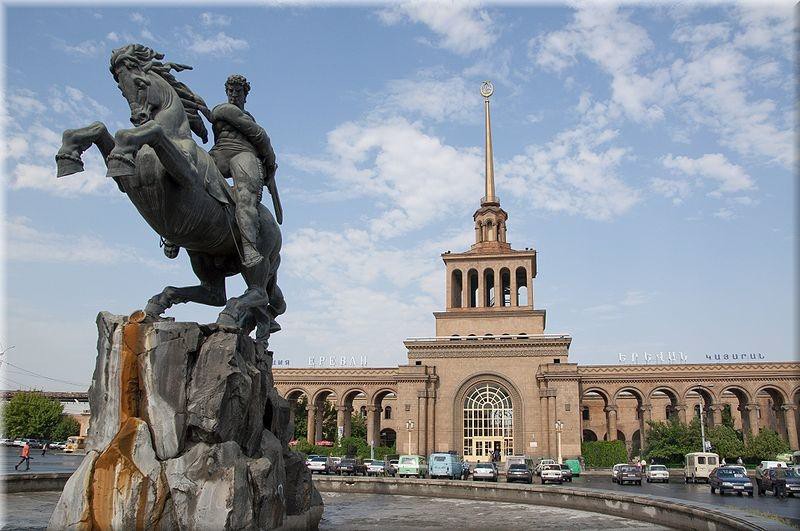
Much has been written about the statue of Davit Sasuntsi. Since the time of its unveiling in 1959, it has travelled the whole planet over, depicted on postcards and magazine covers, in booklets, photographs, and illustrations to book and travel guides. It has become a symbol of the Armenian people’s love of freedom and of their capital, Yerevan.
Yerevan’s monuments to the well-known Armenian composer Arno Babajanyan was originally placedat.
The author is sculptor David Bejanyan. Babajanyan is pictured playing the piano. The statue first appeard in Opera Square several years ago and before it could be officially presented it had created so much uproar that even ex-President Robert Kocharian weighed in on the debate. After seven months the statue returned to its pedestal, where Babajanyan is represented, seated at a grand piano. The bronze sculpture cost about $50.000 given by benefactor Ruben Hayrapetyan who said Bejanyan and an architect donated their work. The artist made subtle changes, but not obvious enough to satisfy critics.
The revised Babajanyan has shorter fingers and his face is more realistic. But in a city filled with serious-faced, static statues of heroes, the one will no doubt continue to divide opinions of onlookers.
Avetik Isahakyan was a famous Armenian poet, writer, academician, member of the Armenian Academy of Sciences and a promimnent public figure.
Isahakyan was educated at the Kevorkian seminary in Echmiadzin, and later at the University of Leipzig, where he studied philosophy and anthrology. He started his literary as well as political careers in his early youth. His verses called on people to fight against national and social oppression. In 1911, Isahakyan emigrated because of persecution by the tsarist authorities.Many people of Yerevan remember the figure of the famous poet, as he walked slowly along the streets, with his inevitable long cane. He would slightly incline his head and reply warmly to the respectful greetings of the passers-by. This is how sculptor Sergei Bagdasaryan has portrayed him, as he stops for a minute in thought, before continuing on his way. The statue of the Armenian poet Avetik Isahakyan was unveiled in 1965.
William Saroyan was an American author who wrote many plays and short stories about growing up impoverished as the son of Armenian immigrants. These stories were popular during the Great Depression.
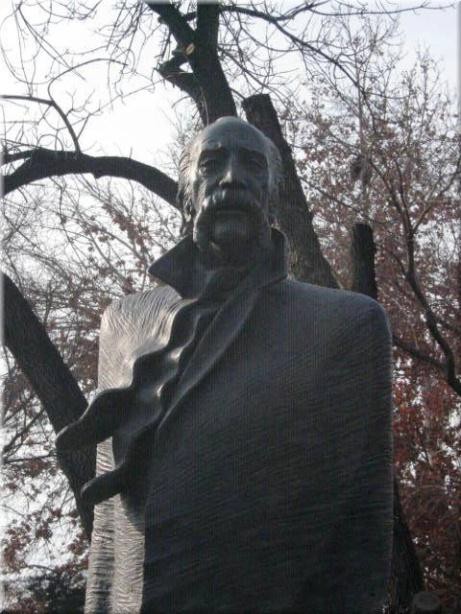
To celebrate the 100th anniversary of William Saroyan’s birth, in November, 2008, a monument to him was unveiled in Yerevan on the corner of Moscovyan Street and Mashtots Street. The statue is the work of architects Ruben Hasratyan and Levon Igityan.
Komitas was one of the most renowned Armenian Churchmen and musician. He wrote over three thousand songs in Armenian, Arabic, Kurdish, and Persian, and also contributed significantly to the modern Armenian Patarak. His main contribution was to rediscover Armenian folk music. His work in arranging and collating the folk music he had collected over the years eventually became excellent songs for chorus music, and made the public aware of the existence of true Armenian music. In addition to the folk music, Komitas arranged the entire music of the Divine Liturgy (Patarak) of the Armenian Church, for male voices.
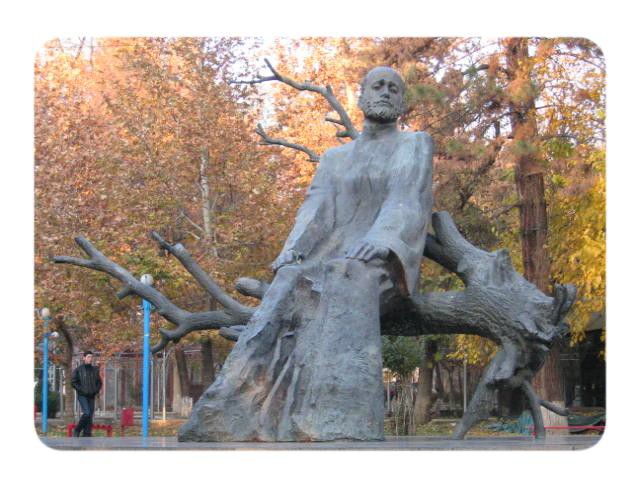 The Park of Komitas
The Park of Komitas
After the 24, 1915 massacres of the Armenian people by the Turks, he succumbed to mental and physical anguish and never fully recovered. Komitas lived as if a walking corpse for the next twenty years. The revered holy man died in Paris on October 22, 1935 in a mental hospital. One year after his death his ashes were transferred to Yerevan and interred in The Yerevan Pantheon.The name of Komitas today is directly or indirectly present in all the different and at times unexpected occurrences. At present one of the oldest and favorite green spots in Yerevan, The Park of Komitas, carries the name of Komitas; it was designed by architect M. Mazmanyan.Yerevan Conservatory is the only musical institution of higher education in Armenia which in 1946 was named after Komitas. Statue of Komitas is situated outside the Komitas Conservatory.
Martiros Saryan was one of the plead of major cultural figures of Armenia at the turn of the century. His work, in common with the library contributions of H. Tumanyan and A. Issahakyan.
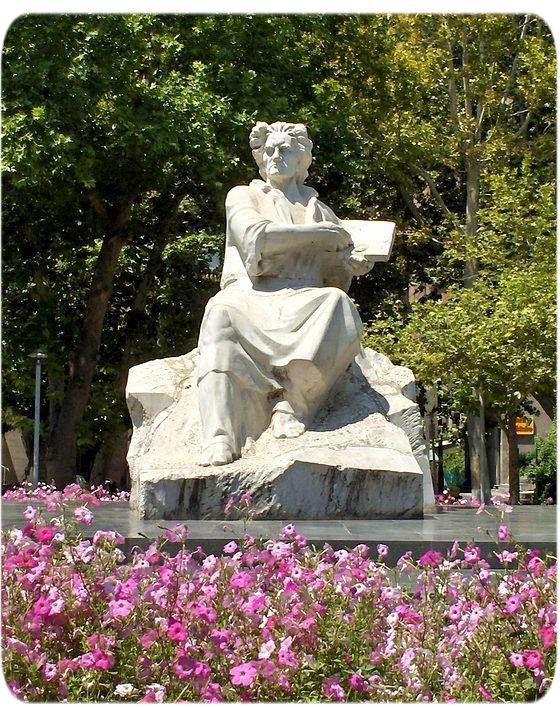
He was born in 1880 and died in 1972. In the course of his long life, Saryan experienced much sorrow and much joy. He witnessed the two World Wars and the tragedy of genocide in Armenia in 1915. He suffered the destruction of many of his paintings, and the death of his beloved son. Saryan was striving to represent nature symbolically as a “living entity”. The works which Saryan began to show at Moscow exhibitions were executed mainly in watercolors and tempera. They include: “Flowering Mountains”, “The Comet”, “By the sea: Sphinx”, “Two Panthers”, “Under the Pomegranate”, “At the Well on a Hot Day” and others. Saryan was famous for his work in the field of book illustration. Saryan also worked in monumental painting and in the sphere of theatrical design.Now where Saryan’s statue is people sell their paintings and this park is called after Saryan.
The original white marble. The Hands Statue was presented by the Italian city of Carrara and respresenting the friendship between two twinned cities.
Yerevan responded by sending the people of Carrara a modal of a spring of water made of tufa, and decorated with national motifs, and an exact copy of this stands in the square too.
Sayat-Nova is considered by many to be the greatest ashik( folk singer-songwriter) that ever lived in the Caucasus. About 220 songs can be attributed to Sayat-Nova, although he may have written thousands more.
In Armenia, Sayat Nova is considered a poet who made a considerable contribution to the Armenian poetry of his century. Although he lived his entire life in a deeply religious society, his poems are mostly secular and full of Romantic expressions.
The monument of Sayat Nova stands in front of the Music School, which bears the poet’s name.
Echmiadzin
The first Armenian Apostolic Church is Echmiadzin. It is the fourth largest city in Armenia. It is the most populous city in Armavir province, about 20 km west of Yerevan. The Echmiadzin Cathedral is one of the oldest churches in the world.
In Echmiadzin there are three other imortant Armenian churches.
The church of St. Gayane, which is distinguished by its harmonious proportions. It was constructed in 630 A.D. in Echmiadzin by Catholicos Ezra. And its design was not being changed up today.
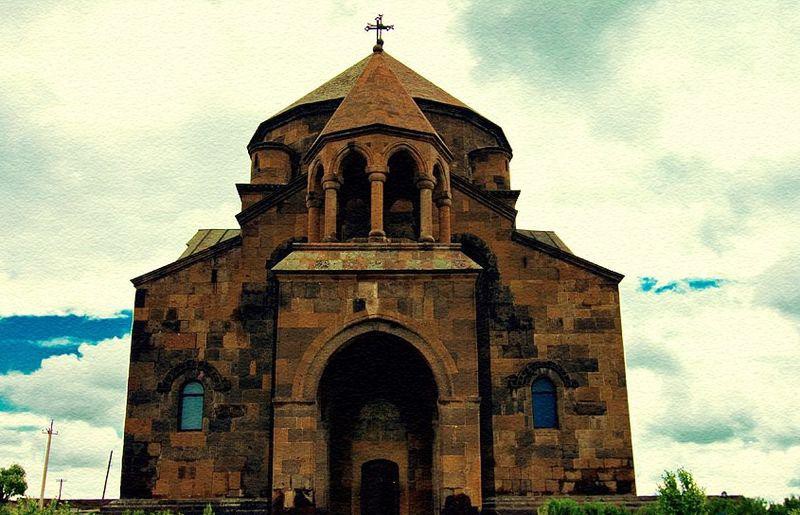 St. Hripsime church
St. Hripsime church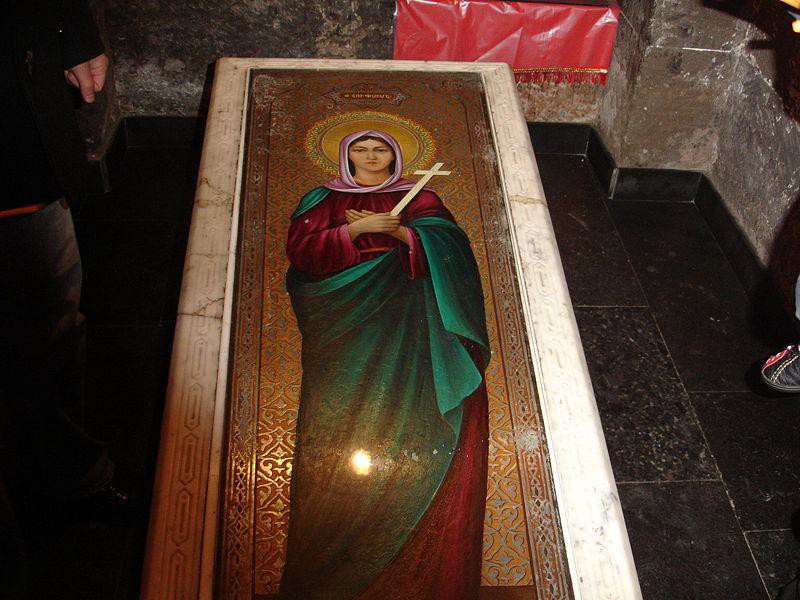 The tomb of St. Hripsime
The tomb of St. Hripsime
The church of St. Hripsime is one of the oldest churches in Armenia, and is known for its fine Armenian architecture of the classical period, which influenced many other Armenian churches. This church was built in 618 A.D.
St. Shoghakat church was built in 6th-7th century but unfortunately has not survived. It is believed that the structure standing at the site today possibly rests on the foundations of the earlier church.
Zvartnots Cathedral
This cathedral is famous for its unique design. The church was built between 643 A.D. and 652 by Catholicos Nerses III.
Zvartnots was a majestic cathedral dedicated to St. George at the place where a meeting between king Trdat III and Gregory the Illuminator was supposed to have taken place. In 930 A.D. the church was ruined by an earthquake, and remained buried until its rediscovery in the early 20th century.
 The ruins of Zvartnots Cathedral
The ruins of Zvartnots Cathedral
Lake Sevan
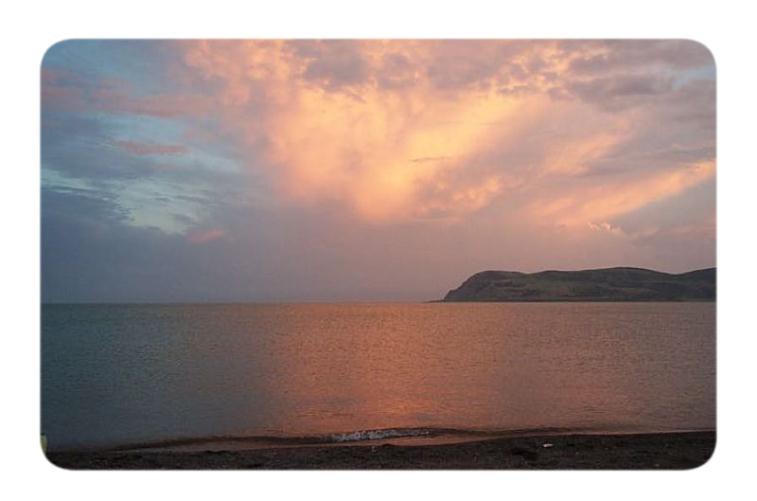 The Lake Sevan in sunset
The Lake Sevan in sunset
Lake Sevan Region is in Armenia. It is a popular summer beach and has many resorts, cabanas, fish restaurants and other interesting places for visitors. Lake Sevan lies at about 2000 meters in elevation, twice that of Yerevan. The
temperatures are significantly cooler than in Yerevan, and the winters much longer. This popular lake is open for visitors in July and August, when it’s warm enough to enjoy beaches and swim in the water.
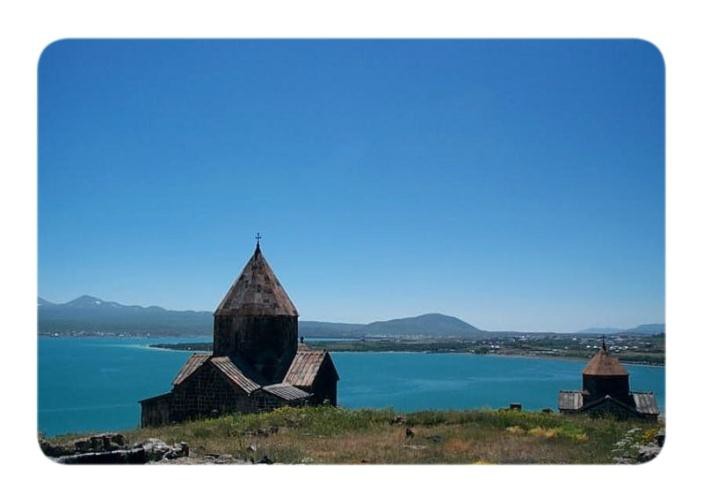 Aghtamar peninsula
Aghtamar peninsula
The most visited destination of the lake is the peninsula known as kghzi, meaning island. The monastery which is called Aghtamar is on top of the peninsula hill and is built of crude black stone on the exterior. The interior has a beautiful old altar used for services by the new seminary down the hill.
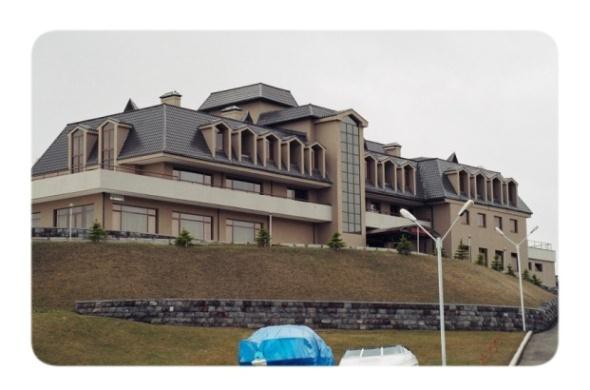 Harsnakar hotel in Sevan are designed and built by famous architect Karen Rashidyan
Harsnakar hotel in Sevan are designed and built by famous architect Karen Rashidyan
Garni Temple
Garni is a temple located in the Kotayk Province of Armenia, situated approximately 32 km southwest from Yerevan. It is very beautiful temple and it is located in very high hill, where you can see Ararat Valley.
Temple has an irregular triangle shape with the sharp ending which is faced the valley. The raise of the temple has leaves twined around lion masks which are so naturally rounded, that it is hard to believe they are carved in stone and not molded. The small square hall with the altar is surrounded by 24 columns with finely carved capitals. An extensively ornamented roofs tops this "temple of coolness" which was used as the summer residence of the kings of Armenia after the country was converted to Christianity.
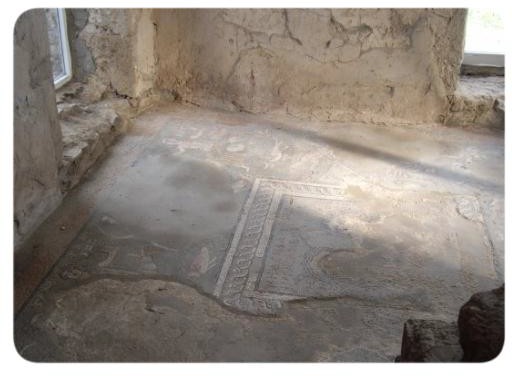
The ruins of the huge palace and baths, built in the 3rd century in the Roman style, are very interesting. The baths were warmed by heated air which passed through ceramic pipes laid under the floor. In the semi circular part of the anteroom, a section of the mosaic floor has remained intact. A story from Greek mythology was taken for a design and was laid out in stones of 15 colors. There is an inscription in Greek which never fails to mystify visitors. It says: "We worked without remuneration".
 The inscription in Greek
The inscription in Greek
Archeologists are still working on the Garni complex. They have discovered many interesting household items, fragments of antique marble statues, inscriptions in Armenian, Aramaic and Greek.
Geghard
The monastery of Geghard is a unique architectual construction in the Kotayk province in Armenia. The monastery was found in 4th century by Gregory the Illuminator and it was known as Ayrivank which means the Monastery of the Cave.
The first monastery was destroyed by Arabs in the 9th century.
The monastery was famous because of the relics that it housed. The most celebrated of these was the spear which has wounded Christ on the Cross, allegedly brought there by the Apostle Thaddeus, from which comes its present name, Geghardavank (The Monastery of the Spear), first recorded in a document of 1250. Today the monastery complex is located at the end of the paved road, and the walk up from the parking lot is lined with women selling sweet bread, sheets of dried fruit(fruit lavash). sweet sujukh( grape molasses covered strings of walnuts) and various souvenirs. A group of musicians usually plays for a few seconds as visitors approach, perhaps willing to play longer for money.
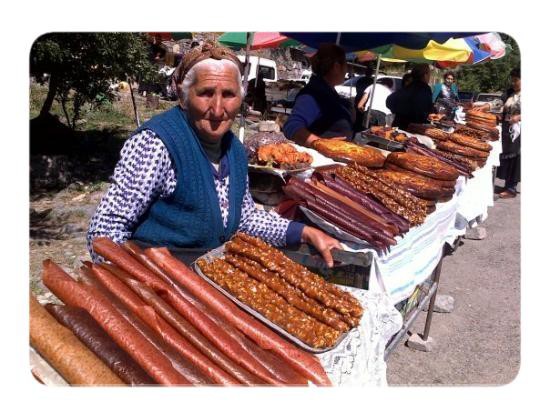 A woman sells sweet bread and sweet sujukh
A woman sells sweet bread and sweet sujukh
Tsakhkadzor
Translated from Armenian the word “Tsakhadzor” means the Gorge of Flowers. Indeed the gorge, the mountains, snow tops, rapid rivers, picturesque valleys are covered with a flower carpet. Tsakhkadzor was an inhabited place in from ancient times. Today’s Tsakhadzor is a very nice city and modern mountain-ski resort.
The Tsakhkadzor ski resort is located just above the town, on a height of 1750 meters above sea level. During the recent years the ski resort was fully modernized.
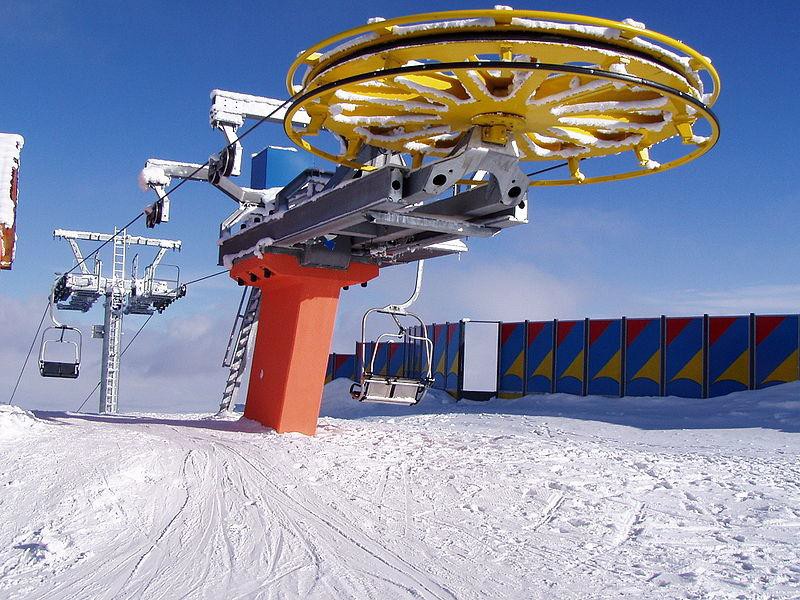 The highest lift on Mount Tegenis(2819m)
The highest lift on Mount Tegenis(2819m)
All ropeway lifts are manufactured and operated by Leitner Group. The Olympic Sports Complex of Tsahkadzor was built specifically for the preparation of the Soviet athletes for the 1968 Summer Olympic Games in Mexico. Today the sports complex which was thoroughly overhauled in 2008, opens its doors to all visitors. The complex provides training facilities for 35 types of sports. It consists of a football stadium, swimming and diving pools, several indoor sport halls and facilities for many other types of sports.
One of the most interesting religious complexes of Armenia is located in Tsakhkadzor. The Kecharis Monastry of the 11th century is a group of 4 churches, and it is one of the well-preserved medieval architectural samples of the Armenian Highland.
Dilijan
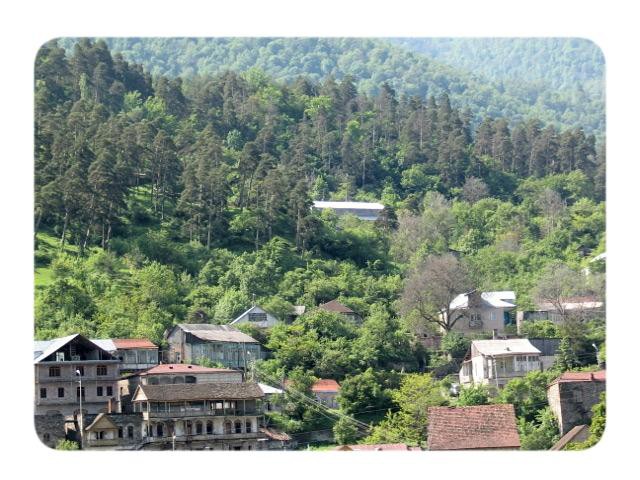 Dilijan town
Dilijan town
Dilijan is a green city located in the northern Armenian province of Tavush. It is one of the most important resorts of Armenia. Dilijan has a rich historicaland cultural heritage.
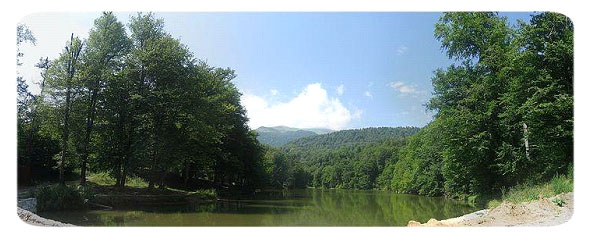 The Lake Parz
The Lake Parz
The Lake Parz is one of the Dilijan’s most attractive natural sites. It has an area of 2 hectares and en average depth of 8 meters.
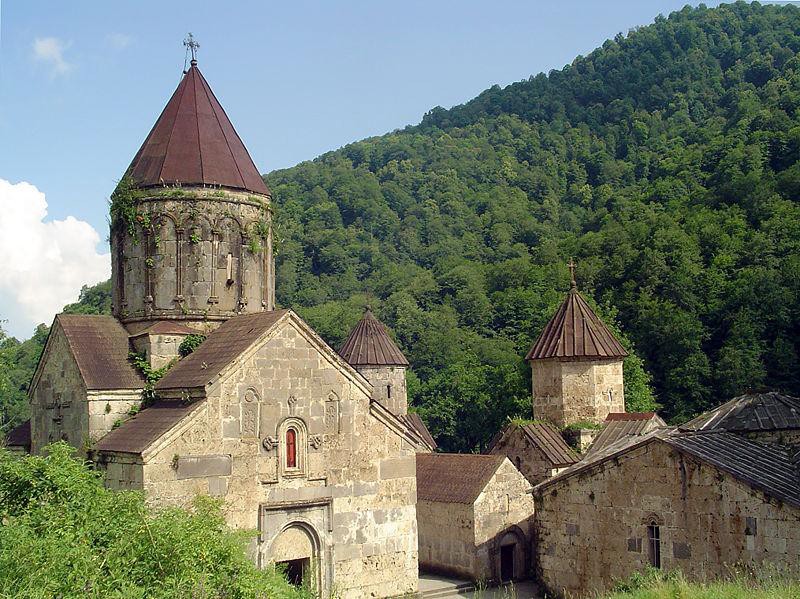 The Haghartsin Monastry
The Haghartsin Monastry
Dilijan’s most popular religious site is the Haghartsin Monastry, which is 12 kilometers east of the city and consists of three churches and dining hall. The monastry was built in the Middle Ages. The oldest of the monastry’s churches is St. Gregory, was built in the 10th century. The other churches St. Stepanos and St. Astvatsatsin, date back to the 13th century. There are a number of khachkars in the complex.
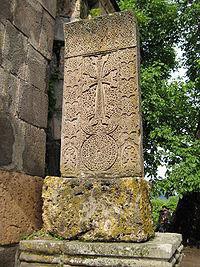 |
|
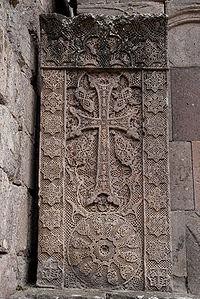 |
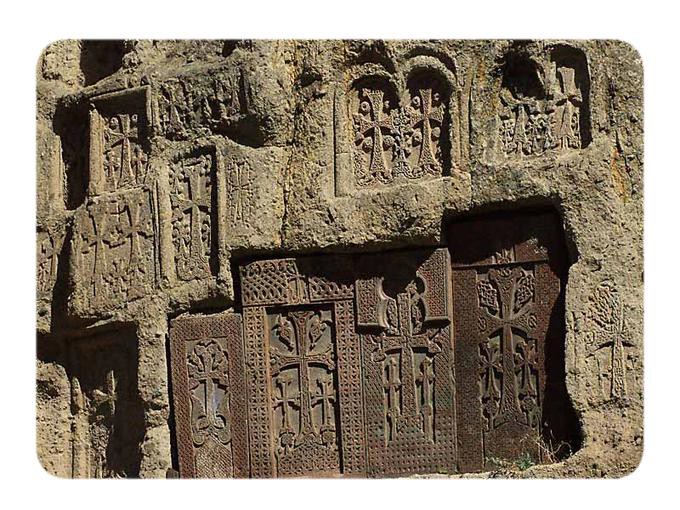
Armenian Khachkar Crosses |
A khachkar is a cross-bearing carved memorial stele covered with rosettes and botanical motifs.
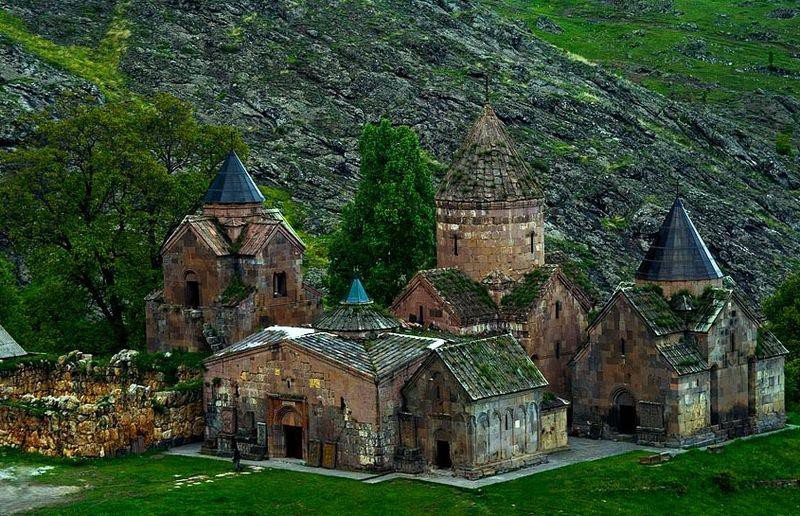 Goshavank Monastry
Goshavank Monastry
Goshavank Monastry of the 12th century was one of the Armenian’s prominent theological centers in the Middle Ages. It is 23 kilometers away from Dilijan.
Khor Virap
The Khor Virap monastery which means deep dungeon monastery is one of the most popular destinations in Armenia. It stands before the snowcapped flanks of Mount Ararat offering a spectacular view of the mountain, the national symbol of Armenia.
It is where Grigor Lusavorich(St. Gregory the Illuminator) was imprisoned for 13 years before curing King Trdat III of a disease. The caused the conversation of the king and Armenia into the first officially Christian nation in the world in 301. In Khor Virap you can visit the underground chamber were he was imprisoned.
There are two holes which can be climbed down but are unmarked. There is one smaller chamber by the door which has some stairs and then twist and a ladder leading to the small room. There is another hole in the main room, to the right of the altar, with a long ladder leading down into the larger cistern where Grigor Lusavorich was imprisoned.
It is actually impressive in size for an underground prison cell, and due to candles and a lack of air circulation was very stuffy, much like the other smaller chamber.
You can also see the green belt along the Araks River which denotes the boundary with Turkey from the monastery and there are some military lookout posts around the area. At night there are lights visible on Mt. Ararat, these are American listening posts and Turkish bases.
The large St. Astvatsatsin church at Khor Virap was built in the 17th century and is typical in design, but with a lack of virtually anydecoration carving or elements. It is located in a fort like complex with a nice courtyard.
Karahunj (Zorats Karer)
Our Armenia destination spotlight is Karahunj (Stones with voice) or alternatively Zorats Karer (Powerful Stones) in Syunik marz, an ancient stone circle. Situated not far from the Vorotan river gorge, and the town of Sisian, the landscape is stunningly evocative and there is no tourist infrastructure to interrupt the view.
Intriguingly, the name Karahunj, points to connections with Stone Henge. Kar means stone in Armenian, and hunj sounds very similar to henge which has no meaning in English. Though generally thought to have been in use from the 1st or 2nd millenium BC, the site, it has been dated by some to the 6th millenium BC, approximately 3,500 years before Stone Henge.
Scientists believe that a temple once stood in the centre of the stone circle dedicated to the Armenian god Ari, name which also refers to the sun. Karahunj is thought by some to be the world's first astronomical observatory.
There are also many legends to account for the circle of stones.
One says that during a wedding, enemies approached with the intention of kidnapping the bride.
After praying to the Gods, the approaching men were turned to stone. High on the nearby mountains there are also many petroglyphs or stone paintings. Most of the season visitors are lucky enough to have the place to themselves. Tourists familiar with British heritage would be astonished to discover the possibility of famous Stonehenge to have been originated in Armenia, claiming the fact that the Armenian land is the real cradle of civilization.

Famous professor and world known specialist on stone monuments Gerald. S. Hawkins had acknowledged that Karahunj is 7,500 years old, which means that it is 3,500 years older than British Stonehenge, older than Karnak in France and Newgrenge in Ireland. It may prove what some people already suspect - that Armenia is the cradle of the civilization. On the territory of 7 hectares, 223 huge vertical stones like soldiers stand on the hill, some with holes pierced in them. The rough- cut stones aligned irregularly for a purpose, 84 were found to have holes. Many unique astronomic instruments consisting of one, two or three stones were identified and using these many observations of the Sun, the Moon and the stars were carried out.
It is commonly assumed to be an early observatory, an evidence of ancient astronomical culture in Armenia. These stones have been attributed with mystical and cosmic powers. The Armenian scientists in ancient times could accurately measure latitude, knew that the Earth was ball-shaped, had an accurate calendar, and many more. The sight is beautiful and ancient, well worth the visit. Astronomers from Europe and the US are showing increasing interest in the complex, and several expeditions have already taken place.
Attractions in Yerevan
The city has a majority of luxury hotels, modern restaurants, bars, pubs etc. The Armenia Marriott Hotel is situated in the heart of the city at Republic Square, while other major chains are also present in downtown Yerevan, such as the Golden Tulip Yerevan Hotel and the Best Western Congress Hotel.
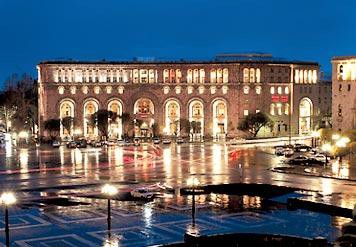 |
|
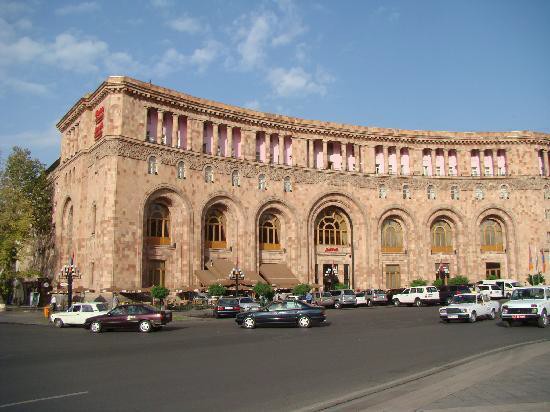 |
The Marriott Hotel |
 The Golden Tulip Hotel
The Golden Tulip Hotel
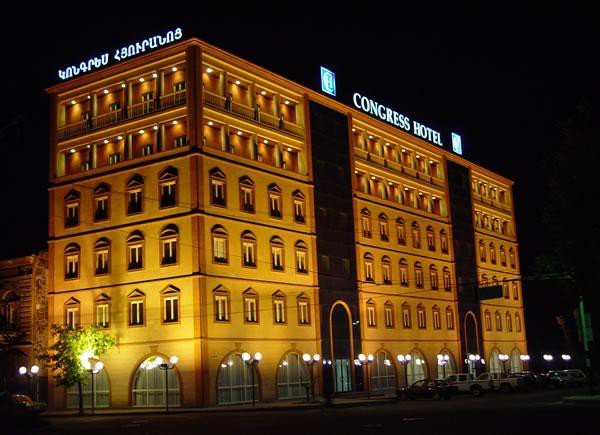 |
|
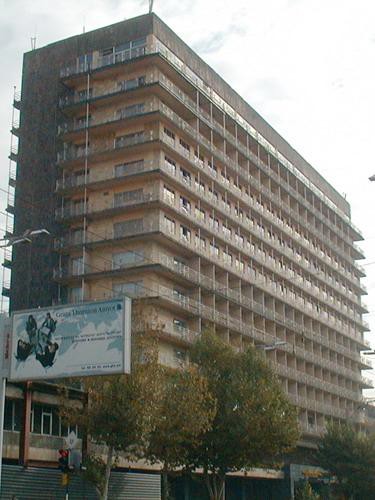 |
The Congress Hotel |
|
Ani Plaza Hotel |
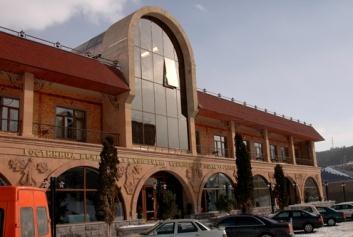 Kecharis Hotel in Tshakhkadzor
Kecharis Hotel in Tshakhkadzor
The Yerevan Zoo was founded in 1940. After experiencing a period of difficulty during the 1990s, the zoo is in better economic shape today. It hosts elephants, eagles, bears, camels and 260 other animal species.
The Waterworld is a water park in Yerevan, It has several pools, toboggans, bars and restaurants. The park used to close from October to May but the construction of an indoor section called Aquatek has permitted the water park to be open all year. The indoor section has Jacuzzis, pools, hammams, fitness rooms, restaurants and hotel.
Armenia is famous for unique cuisine enriched with thousands year old traditions. On top of it Armenians are known for their generosity and perfection in cooking. If you visit Armenian family don’t eat nothing before going there, because without traditional food you will not allowed to go out.
There are many restaurants in Yerevan and new ones open every week and each restaurant has its own style.
For Armenians, ethnic pork barbeque is the same as classic hamburger for Americans. For example Armenians like to prepare barbeque during anniversaries, weddings, but not only during the celebrations, they prepare barbeque just for them. If you want to try Armenian real barbeque you should go to Proshyan Street.
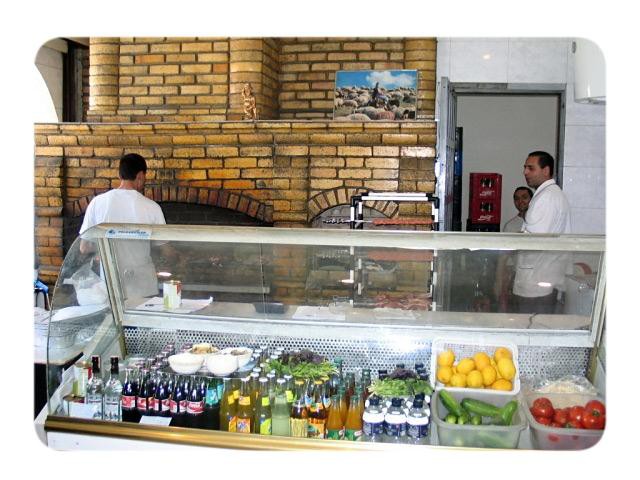 |
|
 |
| Typical Armenian barbeque carryout place in Proshyan Street |
There are many restaurants, where you can find great barbeque. Proshyan Street also known as Barbeque Street.
In Armenia almost every restaurant falls into category, however they all have local flavors. For example, restaurants around Lake Sevan known for their famous fish dishes and in Dilijan for the Oyster Mushroom dishes.
The Old Erivan (Old Yerevan) is one of the most traditional restaurants in Yerevan. The plce has singing and dancing in the traditional style, waiters and waitresses wear Armenian traditional clothes.
The Old Erivan restaurant is located on Tumanyan Street, across from Opera.
Another traditional restaurant is called Mer Gyugh(Our Village). This restaurant is located on Sayat-Nova Street, across from Swan Lake, Our Village is the best place to go in Yerevan for taste of the village. Try some of the exotic things, like buffalo yougurt, chichkhan tea, and “honee oghi).
 Armenian traditional music
Armenian traditional music
There you can listen live traditional music, though it can be a bit loud conversation.
There are also some international restaurants and cafes. Most popular are L’orange, Square One, Pascucci, Astral Disco Club, La Café de Paris, Sayat-Nova Complex. You can also try Armenian pizza in Pizza Di Roma and Dimond.
Sardarapat
Armavir (Sardarapat) is a city located in western Armenia. The city if Armavir in Russia was founded by Armenians in the 19th century, was named after this city. The Battle of Sardarapat was a battle of the Caucasus Campaign of World War I that took place near Sardarapat(modern-day Armavir), Armeni from May 21 to May 29, 1918. Sardarapat was only 40 kilometers west of the city of Yerevan and the battle is currently seen as not only stopping the Turkish advance into the rest of Armenia but also preventing the complete destruction of the Armenian nation.
The battle of Sardarapat holds a special place in Armenian historical memory and is often compared to the 451 A.D. Notable Armenian literary figures such as Hovhannes Shiraz and Paruyr Sevak, whose work “Sardarapat” was turned into popular song, wrote songs and poems that lionized and praised the Armenian fighters.
After the commemorate of the Armenian Genocide’s 50th anniversary in 1965, Soviet authorities agreed to the construction of a monument dedicated to the Armenian victory near the site of the battle. Architect Rafayel Israyelian was commissioned to design the monument, which was completed in 1968.
The Sardarapat Memorial is located 25 kilometers from Echmiadzin. In violation of the Bresr-Litovsk Peace Treaty with soviet Russia, Turkish troops crossed the border in 1918 and attacked Alexandropol(Gyumri). The aggressor intended to crush Eastern Armenia and seize Transccaucasia. When Alexandropol fell, the Turkish Army poured into the Araray Valley- the heart of Armenia. There was a major engagement at Sardarapat on May 22=26, where the Turkish Army was defeated and retreated.
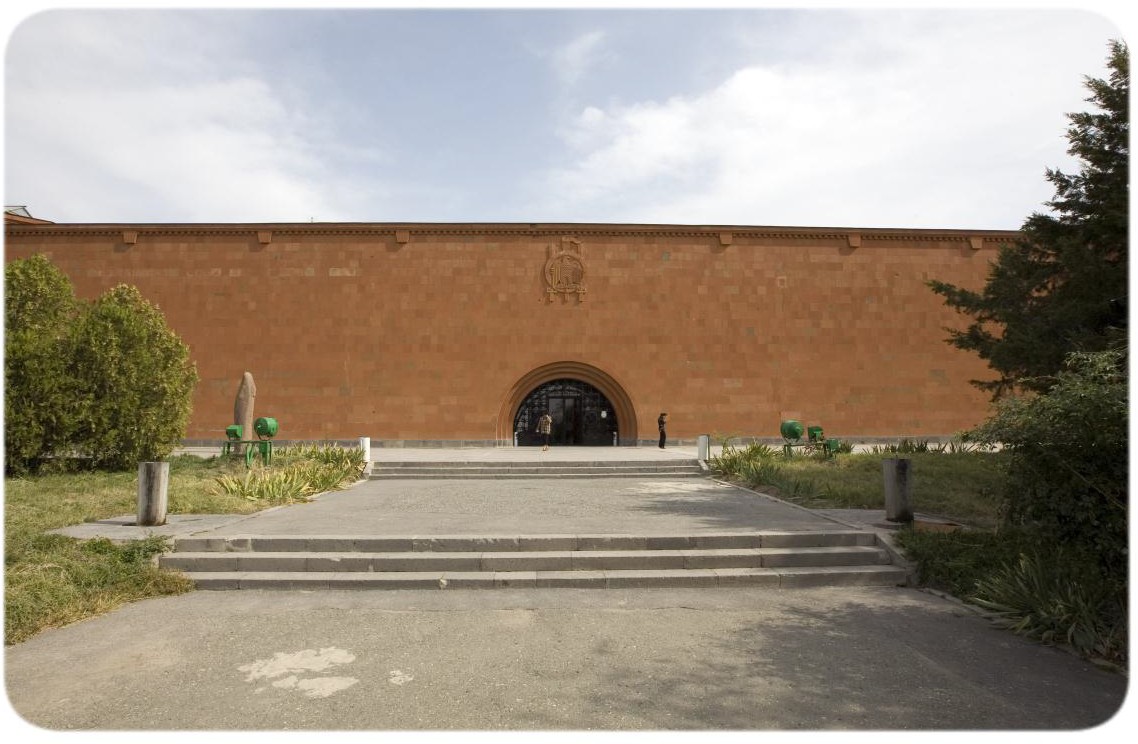
A memorial park was laid out on the battlefield in 1968. The entrance is flanked by huge winged oxen made of red tuff. A flight of steps leads to a square from which a 26-metre- high bell tower rises. The beautiful trellis structure with its nine bells can be seen from afar. The bells ring every year on the day of the historic victory, A lane of eagles, symbolizing the spirit of the fearless fighting men, leads to a curved Wall of Victory( length-55 meters, height-7 meters) with scenes of the battle, and the figure of a woman with a child – a symbol of a revival.
The Sardarapat complex includes a restaurant and a cozy little hotel. The complex was designed by the architect Rafael Israelyan, and sculptors Ara Arutyunyan and Arsham Shaginyan. Visitors are also welcome to drop into the Museum of Ethnography of Armenia on the territory of the park.
Noravank
Noravank is a 13th century monastery, located 122 km from Yerevan in a narrow gorge made by the Darichay river, nearby the city of Yeghegnadzor, Armenia. The gorge is known for its tall, sheer, brick-red cliffs, directly across from the monastery. The monastery is best known for its two –storey St. Astvatsatsin church, which grants access to the second floor by way of narrow stones jutting out from the face of building. The monastery is sometimes called Amaghu-Noravank, Amaghu being the name of small recently destroyed village above the canyon, in order to distinguish it from Bgheno-Noravank Monastery, near Goris. In the 13th-14th centuries the monastery became a residence of Syunik’s bishops and, consequently, a major religious and, later, cultural center of Armenia closely connected with many of the local seats of learning, especially with Gladzor’s famed university and library.
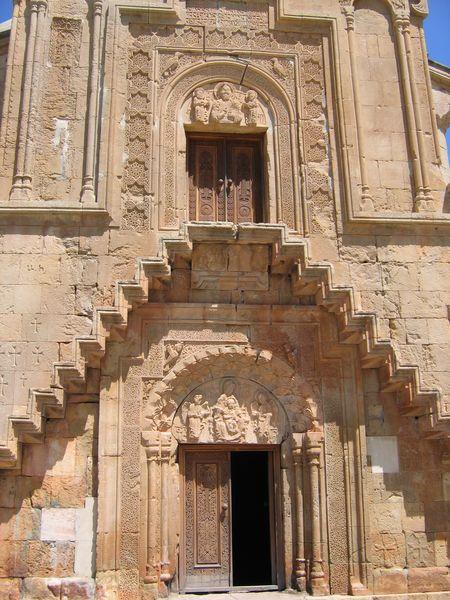
Noravank was founded in 1205 by Bishop Hovhannes, the former Abbot of Vahanank. The monastic complex includes the church of St. Karapet, St. Grigor chapel with a vaulted hall, and the church of St. Astvatsatsin(Holly Mother of God). Ruins of various civil buildings and khachkars are found both inside and outside of the compound walls. Noravank was the residence of the Orbelian princes.
The architect Siranes and the remarkable miniature painter and sculptor Momik worked here in the latter part of the thirteenth and early fourteenth century. The complex was renovated in the late 1990s and early 2000s under the sponsorship of Mr. and Mrs. Hadjetian.
Tatev
Tatev monastery is situated near the village of the same name in part of Zangezur-ancient Syunik. The monastery was founded in the ninth century in place of a tabernacle well- known in ancient times. The strategically advantageous location on a cape formed the construction of a mighty defense complex there. Tatev monuments stand out for high quality of building work. At one time Tatev was the political center of Syunik principality. In the 10th century it had a population of 1,000 and controlled numerous villages. In the 13th century it owned 680 villages, though some of the hippie villages fought hard to stay out of Tatev’s hold.
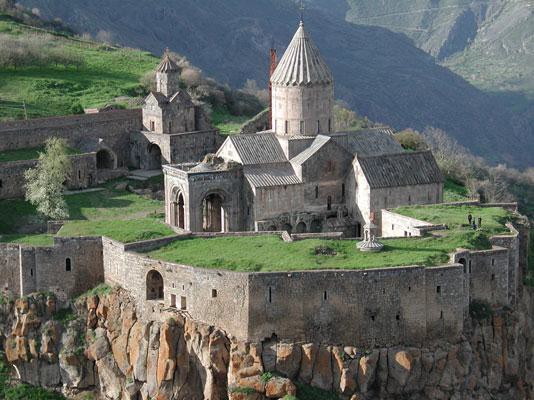
The earthquake of 1931 caused enable us to judge about the artistic merits of the complex. The main monument is the Church of Pogos and Petros built in 895-906. It reproduces the type of domed basilicas of the 7th century, but has new features. In the stretched out interior, the middle nave, crowed with a tremendous in the middle of the plan’s cross, predominates. As distinct from the domed basilica, the church had in its western part several annexes the comers of which served as the abutments of the dome. Its eastern abutments did not yet merge with the walls of the altar apse; consequently, the cross-winged shape of its interior is not too well pronounced. These features give us grounds to regard the church as an intermediate link in the development of the cupola hall into a cross-winged, dome type of building which became widely spread in Armenia later.
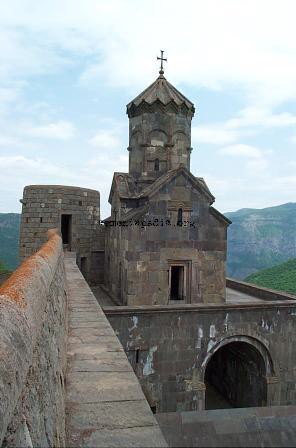
The facades of the church, just as those of the 17th-century monuments, are smooth and free of superfluous detailing. On the eastern façade there are two deep triangular niches crowned, just like the windows, with thin ornamented edges. Four of them are decorated with representations of human faces, to which snake heads with strings sticking out are turned. Armenians believed snakes to be the protectors of their homes. The oval-shaped faces, with long locks of hair framing them and with eye sockets merely hinted at, are rather schematic. The only exception is the relief of the northern façade in which the carver tried to portray someone. According to Stepanos Orbelyan, an Armenian historian, these are portraits of the founders of the church-Prince Ashot, his wife Shushan, Srigor Supan, the ruler of Gekharkunik, and Prince Dzagik.
 |
|
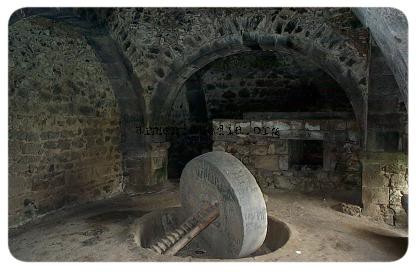 |
The mall in outside building |
Special attention was paid to the interior decoration of the church which was the main cathedral of Syunik principality. In 930 the walls of the church were decorated with frescoes, now almost totally lost, which differed from those of the Church of the Cross on Aghtamar Island. In the main apse there was taken up by an enormous fresco showing the Doomsday, and northern wall, be scenes of Nativity. The figures on the frescoes are monumental and shown in carious complex movements which are emphasized by the folds of the attires. The refined color scheme of white, light-blue, yellow and dark red gave the interior a smart and solemn look.
 Cathedral interior
Cathedral interior
Tatev ensemble fits in perfectly with the mountainous landscape around it. A large church, dominating the surrounding structures and visible from afar, is the architectural and artistic center of the ensemble. The residential and service premises, arranged in a single row on the perimeter, set off the polyhedral rock foundation and seem to be an extension of it. This gives the ensemble an original and majestic appearance.
Jermuk
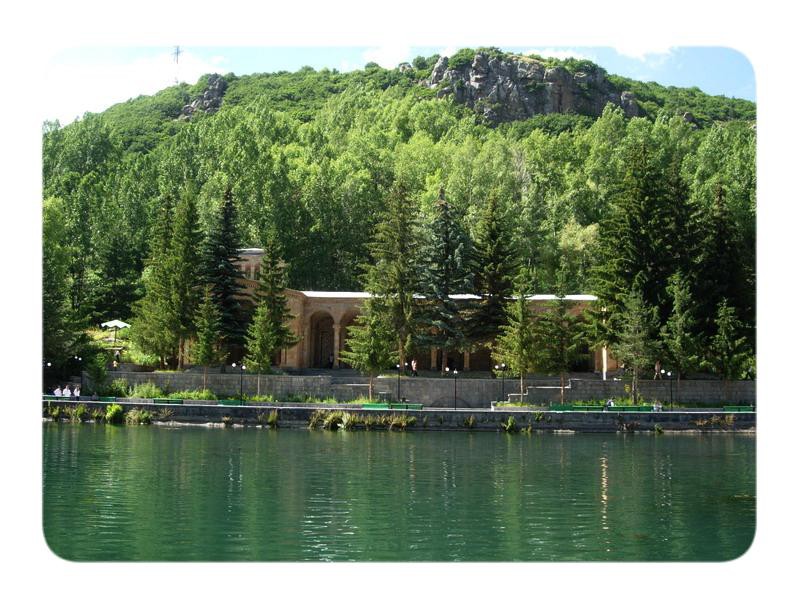 Jermuk sanatorium
Jermuk sanatorium
Jermuk is a town-resort in the southern Armenian province of Voths Dzor, 53 km east Yeghegnadzor, the capital of Vayots Dzor. It was a popular destination during the Soviet era and nowdays is still famous for its hot springs and its brand of mineral water that is bottled in the vicinity. The town is considered to be attractive for its huge waterfall, the natural bridge, the lake, its forests with the walking trails and mineral water pools. Jermuk is currently being redeveloped to become a modern centre of tourism and health services. The distinctively fresh air makes Jermuk unpolluted.
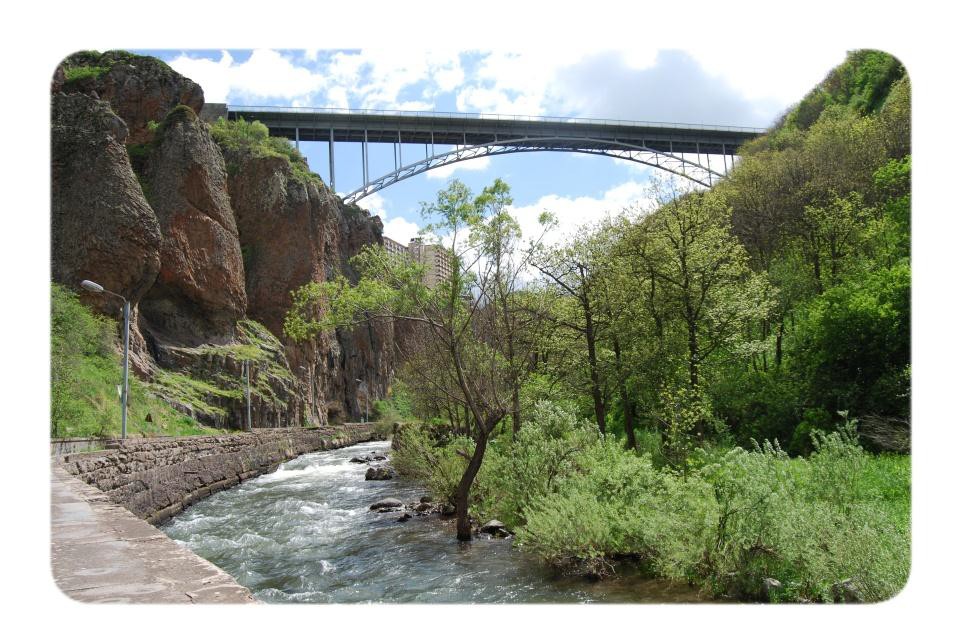 Jermuk bridge and Arpa river
Jermuk bridge and Arpa river
In ancient times the mineral water of Jermuk was known for its curing features. The princes of Syunik regarded the Jermuk sources and water as healing and built several pools filled with it, thereby making the little town their holiday destination.
In 1860s, all the historic pools of Jermuk which were built by Orbelian princes of Syunik, were renovated by “Gevorg Khanagyan”, following a resolution by the Russian government. Tofay, those baths which are called “Pristav Pools”, are preserved as historical monuments.
The forests of Jermuk are rich with oak and hombeam trees, as well as with dog rose, wild pear, plum and juniper plamts. Animals like foxes, rabbits, badgers and bears could be found there.
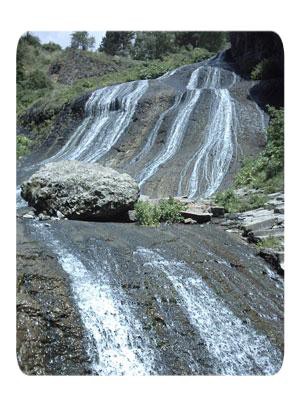 |
|
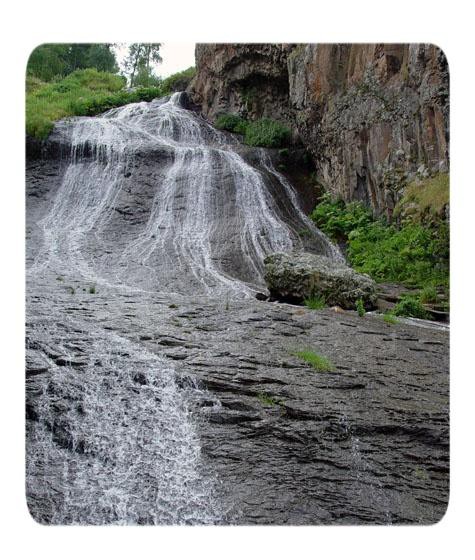 |
| Jrvezh |
Jermuk is full of natural hot springs(Geysers). The name itself is derived from this fact, as the word “jermuk” means “geyser” in the Armenian language. The waterfall of Jermuk on Arpa river has a height of 70 meters.
The average temperature if Jermuk is +15.3C during summer and -9C in winter with level of 800mm of annual precipitation.
The natural water bottling industry has its deep roots in the town as the first factory was founded in 1951. Nowdays, Jermuk is home to many giant factories which produce bottled mineral water. The sparkling water of Jermuk is largely exported to markets around the world.
One of the most attractive nearby destinations is the Gndevank Monastery, located just 10 km west of Jermuk. This monastery is more than 1000 years old.
Jermuk is a great place to spend as much time as you can spare to relax and get away from it all. There is one main north to south highway in Armenia, and Jermuk is easily found off of this main road. About 25 minutes off of the highway, it is a nice way to cut the drive from Yerevan to Tatev Monastery or Karabagh in half.


